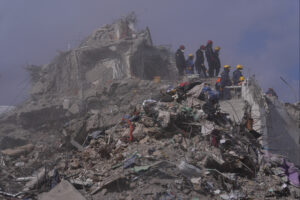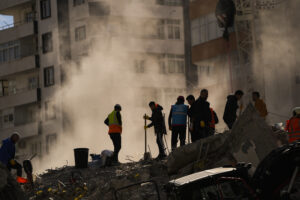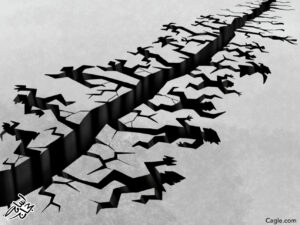On the Angst Over the ‘Big One’ Reportedly Headed for Seattle
That New Yorker article about the apocalyptic earthquake looming in the Pacific Northwest’s near future has driven many in the region to unusual levels of anxiety, writes Emma Brockes at The Guardian. Modern Event Preparedness
Modern Event Preparedness
That New Yorker article about the apocalyptic earthquake looming in the Pacific Northwest’s near future has driven many in the region to unusual levels of anxiety, writes Emma Brockes at The Guardian.
“An earthquake will destroy a sizable portion of the coastal Northwest,” author Kathryn Schulz said in the article, titled: “The Really Big One.” “The question is when.”
“In the Pacific Northwest,” Schulz continued:
everything west of Interstate 5 covers some hundred and forty thousand square miles, including Seattle, Tacoma, Portland, Eugene, Salem (the capital city of Oregon), Olympia (the capital of Washington), and some seven million people. When the next full-margin rupture happens, that region will suffer the worst natural disaster in the history of North America. Roughly three thousand people died in San Francisco’s 1906 earthquake. Almost two thousand died in Hurricane Katrina. Almost three hundred died in Hurricane Sandy.
FEMA projects that nearly thirteen thousand people will die in the Cascadia earthquake and tsunami. Another twenty-seven thousand will be injured, and the agency expects that it will need to provide shelter for a million displaced people, and food and water for another two and a half million. “This is one time that I’m hoping all the science is wrong, and it won’t happen for another thousand years,” Murphy says.
In fact, the science is robust, and one of the chief scientists behind it is Chris Goldfinger. Thanks to work done by him and his colleagues, we now know that the odds of the big Cascadia earthquake happening in the next fifty years are roughly one in three. The odds of the very big one are roughly one in ten. Even those numbers do not fully reflect the danger—or, more to the point, how unprepared the Pacific Northwest is to face it. The truly worrisome figures in this story are these: Thirty years ago, no one knew that the Cascadia subduction zone had ever produced a major earthquake. Forty-five years ago, no one even knew it existed.
Brockes observes of the piece and the visible reactions to it:
The remarkable thing about the Schulz piece is the nature of the scientific predictions: that, within the next 50 years, there is a 30% chance of a catastrophic earthquake with a magnitude of between 8.0 and 8.6 hitting the Pacific north-west, and a one in 10 chance of an even worse quake striking the region in the same period.
The response from Seattle and the surrounding area to the piece, which cited projections of 13,000 dead, 27,000 injured and a million refugees, has been understandably freaked. “New Yorker scares the bejesus out of NW,” wrote the Seattle Post-Intelligencer. “A terrifying read,” wrote the Seattle Times. “Did the New Yorker’s earthquake article scare the crap out of you or what?” asked Seattle Curbed, a real estate website.
There are lots of things residents can do to improve their chances, wrote Schulz, most of them cheapish fixes involving bolting down bits of their house to the floor and removing heavy objects from high shelves. For the rest of us, a piece of concrete advice that suddenly made the whole thing seem real: if you are going on vacation to the Pacific north-west, the writer suggests, don’t stay inside the tsunami zone – a 700-mile stretch of coastline going up into Canada, although stretching as little as three miles inland. Tourists with no flashlight, no evacuation drill and no clue as to the direction of higher ground will almost certainly perish.
Read more here.
— Posted by Alexander Reed Kelly.
Your support matters…Independent journalism is under threat and overshadowed by heavily funded mainstream media.
You can help level the playing field. Become a member.
Your tax-deductible contribution keeps us digging beneath the headlines to give you thought-provoking, investigative reporting and analysis that unearths what's really happening- without compromise.
Give today to support our courageous, independent journalists.






You need to be a supporter to comment.
There are currently no responses to this article.
Be the first to respond.